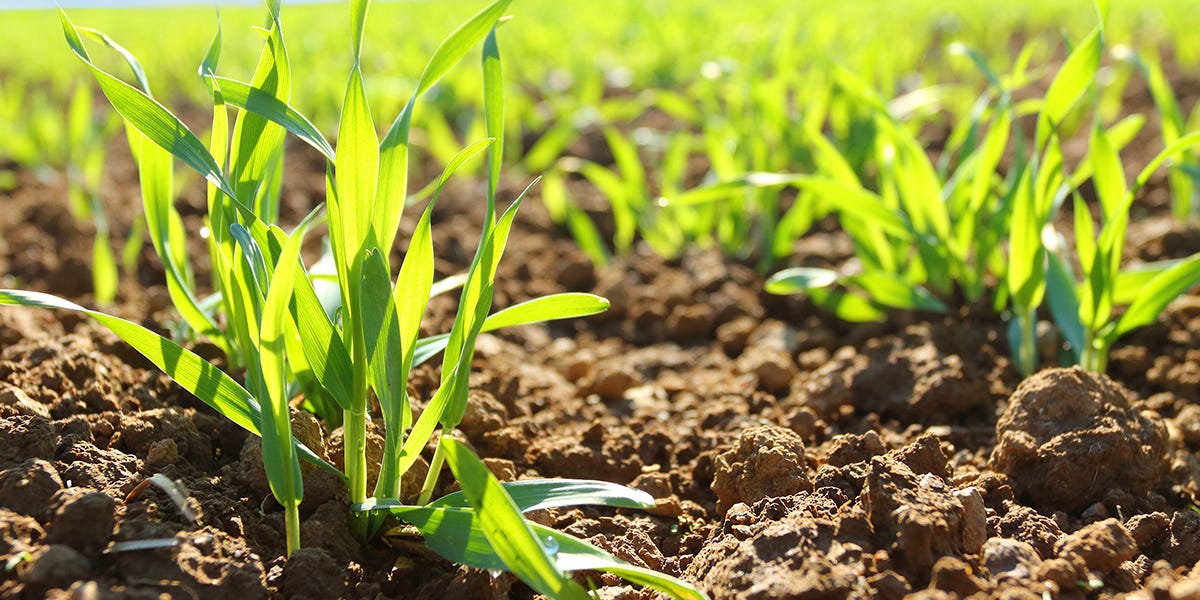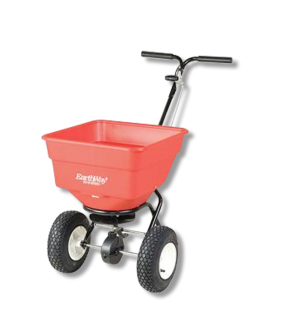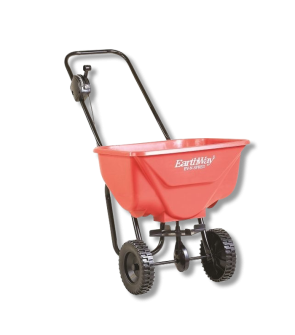How to Care for Newly Planted Seeded Lawn
Most Effective Products
How to Care for Newly Planted Seeded Lawn
This page is a general newly seeded lawn care guide. Using the products and tips suggested you can achieve faster and greater results of any newly seeded lawn.
As your lawn becomes thin, weak, or has bare brown spots then it may be time to plant new grass seeds. By planting new grass seeds you can achieve a greener and fuller lawn that will be the source of envy amongst your neighbors. Not only does a freshly planted lawn look better, but it will help prevent weeds and other diseases from growing in your turf.
Just as it sounds seeding your lawn is planting new grass seeds a few inches below the soil of your lawn. With a little time and patience your seeds will mature and sprout into healthy turf grass.
If your lawn is starting to look thin or worn out, our step-by-step DIY care guide will show you exactly what beginning gardeners or homeowners need to do when planting new seeds within their turf. By following the recommended steps and products you can effectively grow your seeds into a vibrant and thick lawn.
What Type of Grass Do You Have In Your Lawn?

Before you plant new grass seeds into your turf, it is important to know what type of grass you have in your lawn. This will be determined on the location and climate of your area.
For example, while there are many species of grasses they will belong to two groups known as warm-seasoned grass or cool-seasoned grass.
Warm-seasoned Grass
In hot or humid areas that are between 85 to 90 degrees Fahrenheit are best suited for warm-seasoned grasses. Typically, this will be in the southern half of the United States in states such as Texas, South Carolina, Georgia, Alabama, Mississippi, Louisiana, Florida, California, Arizona, Arkansas, and New Mexico.
Common species of warm-seasoned grasses are Bahiagrass, Bermudagrass, St. Augustine grass, Centipede grass, Zoysiagrass, and Carpetgrass.
Warm-seasoned grass will not thrive in cooler winter months and will become dormant typically from November to January.
Cool-seasoned Grass
Cool-seasoned grasses are often referred to as northern grasses because they are typically grown in the northern region of the United States where climates are normally between 65 to 75 degrees Fahrenheit.
Cool-seasoned grasses will grow in the winter or cooler months, and become dormant or brown in hot weather. Normally, in the second half of spring (April) and the summer months (May to August) the grass go into dormancy.
Examples of cool-seasoned grasses are Kentucky Bluegrass, Fescues, Bentgrass, Annual Ryegrass, Perennial Ryegrass, and Creeping Bentgrass.
If you are still unsure as to what type of turf your lawn has then you can consult with your local extension office, governed by the national pesticide information center or refer to Solutions Grassy Weed Control Guides.
Treatment
Before applying the following steps and products, make sure you have the appropriate personal protective equipment (PPE) such as gloves, masks, safety glasses or face shield, long-sleeve shirt, long-sleeve pants, closed-toe shoes with socks, and a coverall or Tyvek suit.
Step 1: Prepare the Ground by Mowing or Raking

To help prepare your new lawn then you will need to remove existing damaged turf by either mowing or raking.
For large scale areas where the turf is dead, you will want to go ahead and mow. Adjust the blades on the mower to the lowest setting to scalp the yard. You want to scalp the yard to allow seeds to reach the soil as easily as possible. Normally, you want to avoid this, but since the turf is too far gone to recover it will not hurt to perform this step.
Now for areas where there are still patches of green turf, you will want to remove excess layer of dead grass roots and blades (known as thatch) by raking. Raking bare ground areas (will look like brown spots in your turf) before applying new seeds will also help your seeds make contact with the soil more easily and lessen compact soil.
Step 2: Apply Seed at Right Time of Year

Choose a grass seed that will thrive in your climate and location.
Warm-seasoned grass seeds should be planted in the second half of spring when the weather is warmer and to the late summer (July).
For cool-seasoned grass seeds you will want to plant in the fall (second half of August to first half of October) when the soil is still relatively warm from summer. When you plant your cool-seasoned grass you will want to give your seeds enough time to germinate two months before the first frost of winter.
Before proceeding to the following steps, wait at least 30 to 45 days to allow your seeds to become established. You may water your newly planted seeds after application.
Step 3: Water Your Seeds Infrequently

Keep in mind that a newly planted lawn will take consistent watering more than an established lawn. If not followed vigorously, then the results will not be as effective.
There is not a precise measurement of water to be given for newly seeded turf, but you will need to keep your seeded turf moist and not to the point of run-off. If you are seeing puddles of water then you have given your seeds to much water.
We recommend using a hose-end sprayer, so you can adjust the setting to a light fan spray setting to avoid washing the seeds away from turf. If you are using a sprinkler system, then use an oscillating or rotator head sprinkler system for gently watering newly seeded turf.
Lightly water the lawn once a day in the morning and again in the evening if the seed dries out. For evening applications, spray several hours before dark to avoid your seeded turf from retaining water.
Once your seeds germinate and emerge from the surface you will keep following the recommended steps, but will need to spray an inch of water no more than once a week.
Step 4: Fertilize Turf After Seeds Become Established

Once the seeds from turf has reached an height of one to two inches then you may apply a starter fertilizer.
You will want to avoid using a weed and feed fertilizer due to these products ability to target pre-emergent weeds underneath the soil. If a weed and feed fertilizer is applied to your soil then it will inhibit your seeds from growing.
Starter fertilizer are specially formulated to contain a higher phosphorous level, the middle number in the three set of fertilizer numbers. Phosphorous is especially needed to help promote new root growth of freshly planted seeds.
Once you have selected your fertilizer you will need to use a push or broadcast spreader for application. Determine how much starter fertilizer to use by measuring the square footage of the treatment area. Follow the formula (length X width = square footage) to find out how much square footage is in your treatment area.
Then, load the measured amount of fertilizer into your spreader and begin broadcasting the product at the edge of your treatment area. You will walk all the way around your treatment area in a straight line keeping a moderate pace as you walk. Once you have treated the perimeter of your treatment area then walk back and forth across the turf until the space in the middle is covered.
After evenly applying your fertilizer you will water the lawn 1 to 2 days after.
Step 5: Apply Weed Control

You will want to apply a post-emergent herbicide like MSM Turf Herbicide when your seeded lawn has been mowed at least three times. Typically, this will be at least one to two months after seeds have emerged from turf.
Remember, when the grass exceeds a height of 3 inches you can mow your turf. If applied when grass is still young or has not been mowed three times then it may be damaged if herbicide is sprayed too soon.
We recommend using a post-emergent like MSM Turf Herbicide because it will need to make contact with the leafy plant tissue of the emerged weed. This product does not work as a pre-emergent and will not target weeds beneath the turf soil, thus it will not unnecessarily damage grass seeds.
For easier control and application upon targeted weeds, a handheld pump sprayer will work best for direct spot application on weeds. Before applying MSM Turf, calculate how much product to use based on the square footage of your treatment area. You can do this by multiplying the length and width of the treatment area together (length X width = square footage).
The general mix rate is 0.025 to 0.05 fl. oz. of MSM Turf Herbicide per 1 gallon of water per 1,000 sq. ft.
Key Takeaways
When Can I Plant New Grass Seeds?
- Depending on the type of grass seeds and whether it belongs to warm-seasoned or cool-seasoned grass will vary the time of seeding. A general rule is if it is a warm-seasoned grass you will want to plant seeds in the first half of spring to late summer. For cool-seasoned grass seeds you will plant in the early fall (September) and at least 1 month prior to when the ground freezes in your location.
What is the First Thing To Do When Planting New Seed into Your Lawn?
- Watering your newly seeded lawn is a crucial step that needs to be continuously completed. You will want to lightly water your seeded area until it moist, but not to the point of water gathering in puddles. For best results, water once in the morning and again in the evening if seeded area is not lightly moist. You may return to a regular water schedule when grass seeds reach a height of three inches.
What to Avoid When Caring for Newly Seeded Turf?
- You will want to avoid treating your newly planted seeded lawn until 30 days have passed. If treated appropriately, your seeds will have become established. During this time, you may apply a starter fertilizer that contains a high phosphorous level. Do not apply a weed and feed fertilizer for this will work into turf roots to eliminate pre-emergent weeds and unintentionally kill your seeded turf. Once your turf has been mowed at least three times then you may apply a post-emergent herbicide like MSM Turf.














































































































































































































































































































































































































































































































































